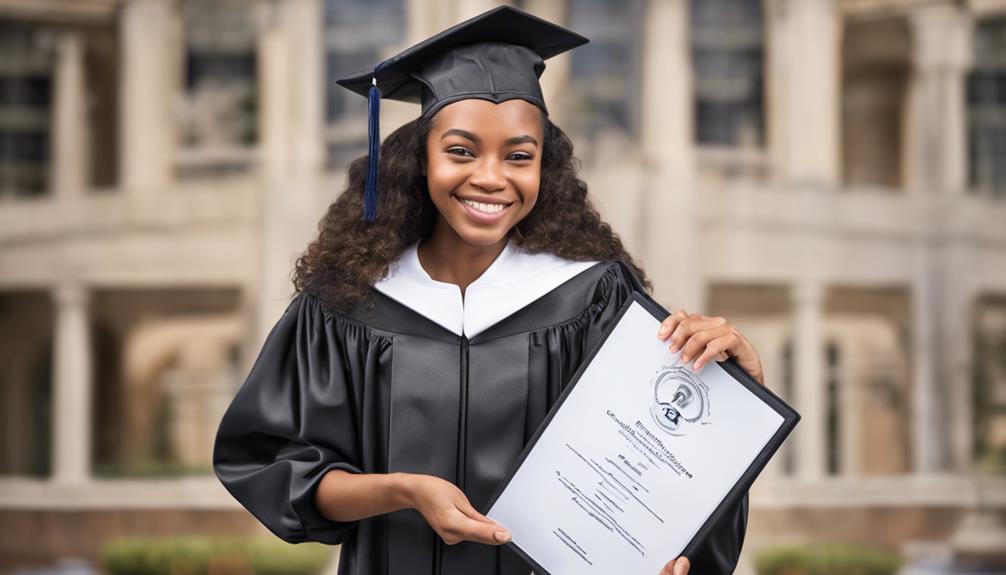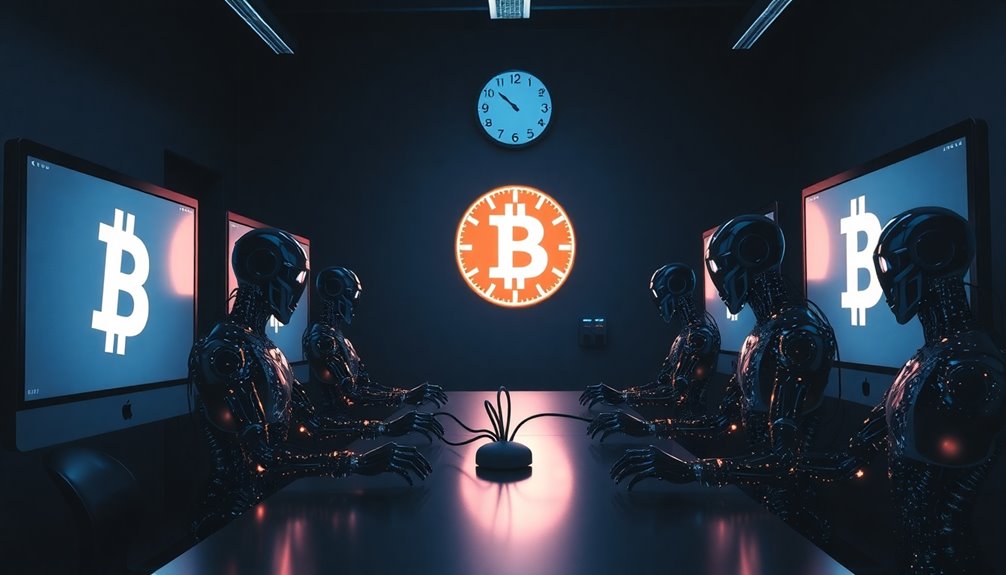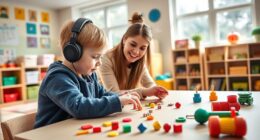Reflecting on the incredible accomplishment of the first deaf-blind individual to achieve a Bachelor of Arts degree, Helen Keller’s historic success at Radcliffe College in 1904 opened doors for many others in similar circumstances.
The hurdles she overcame and the milestones she reached serve as a testament to human resilience and the power of unwavering determination.
Keller's story is not just one of personal triumph but also a beacon of hope and inspiration for all who strive to overcome adversity and achieve their dreams.
Key Takeaways
- Helen Keller overcame deaf-blindness to become the first to earn a BA, inspiring advancements in disability rights.
- Innovative communication methods and family support were pivotal in Keller's academic success.
- Accessible education tools like Braille and tactile signing are essential for deaf-blind individuals.
- Keller's advocacy extended beyond disabilities to women's suffrage, labor rights, and pacifism.
Early Life and Challenges Faced
In the early stages of her life, Helen Keller encountered profound challenges due to losing her sight and hearing at just 19 months old. Being both deaf and blind presented unique obstacles in communication and learning for Keller. These challenges could have easily deterred her progress, but Keller's early resilience shone through as she started speaking at an incredibly young age of 6 months and walking by 1 year old, showcasing her determination to overcome adversity.
Anne Sullivan, Keller's devoted teacher, played a pivotal role in introducing her to innovative communication methods, such as finger spelling. Sullivan's dedication and patience opened up a whole new world for Keller, enabling her to break through the barriers of her disabilities.
Despite the hardships she faced, Keller's indomitable spirit propelled her forward. Her journey from the Horace Mann School for the Deaf to graduating cum laude from Radcliffe College in 1904 is a testament to her unwavering perseverance and the transformative power of effective communication methods.
Family Support and Encouragement
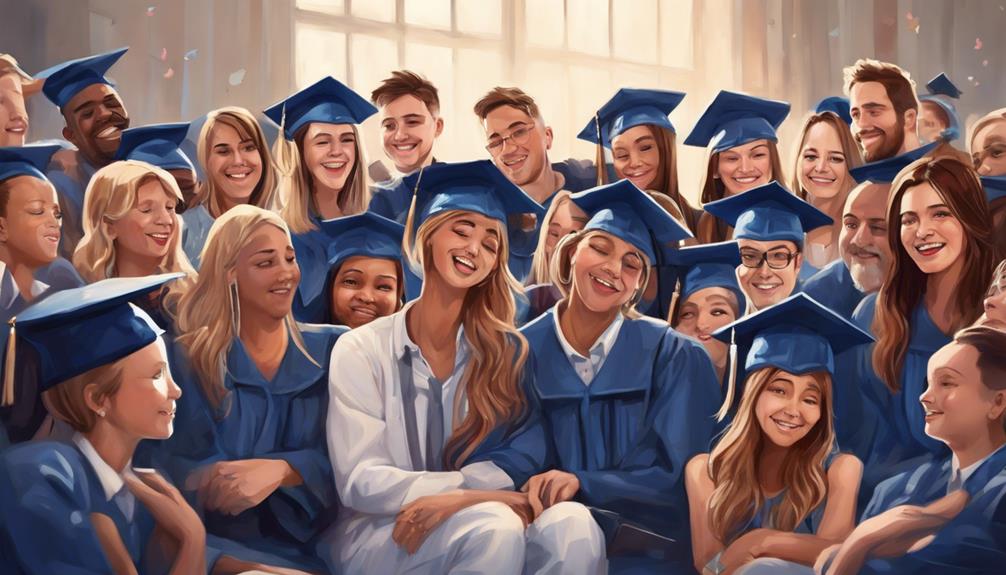
Receiving unwavering support and encouragement from her family, particularly her parents, Arthur H. Keller and Katherine Adams Keller, was pivotal in Helen Keller's remarkable journey as the first deaf-blind person to earn a Bachelor of Arts degree. Keller's family provided not only emotional backing but also financial stability derived from a cotton plantation, granting her access to essential educational resources. Growing up in a nurturing environment, despite her disabilities, enabled Keller to flourish. Her family played a crucial role in facilitating her communication and learning processes from a young age, setting the stage for her future academic achievements.
| Family Support and Encouragement |
|---|
| Financial Stability |
| Nurturing Environment |
| Communication |
| Learning Processes |
| Academic Achievements |
Education and Learning Strategies
As we explore education and learning strategies for individuals with sensory impairments, it's crucial to highlight the significance of learning tools tailored for the deaf-blind community.
These tools, such as Braille and tactile sign language, play a vital role in enabling access to education and fostering effective communication.
Learning Tools for Deaf-Blind
Utilizing tactile sign language, Braille, and adaptive technology serves as crucial aids for deaf-blind individuals in accessing educational opportunities. Deaf-blind students often rely on tactile signing, where signs are felt on their hands, to communicate with teachers and peers effectively. Tactile graphics, like raised-line drawings, play a vital role in helping these students comprehend visual information such as maps and diagrams. Individualized education plans (IEPs) tailored to each student's unique needs are essential, encompassing specialized instruction, communication methods, and support services. Educators undergo specific training to facilitate tactile communication, implement assistive technology, and create inclusive learning environments. This comprehensive approach ensures that deaf-blind students receive the necessary tools and support to thrive academically.
| Learning Tools | Description | Importance |
|---|---|---|
| Tactile Sign Language | Communication via touch on hands | Facilitates effective interaction |
| Braille | System of raised dots for reading and writing | Enables access to written materials |
| Adaptive Technology | Tools like screen readers and magnifiers | Enhances digital accessibility |
| Tactile Graphics | Raised-line drawings for visual information | Aids in understanding maps and diagrams |
Adapted Curriculum Approaches
Our exploration now shifts to examining how adapted curriculum approaches in education and learning strategies have positively impacted individuals like Helen Keller, emphasizing hands-on learning and individualized instruction tailored to unique needs. Helen Keller's education journey was shaped by specialized techniques in tactile signing and manual communication, utilizing tactile sign language and Braille.
Her learning process involved adapted materials in Braille and raised print, allowing access to educational content. Additionally, Keller benefited from the use of physical objects, models, and real-life experiences, enhancing her sensory experiences and overall comprehension. The guidance of Anne Sullivan played a crucial role in delivering individualized instruction, highlighting the importance of personalized approaches in education for individuals with unique needs.
- Utilization of tactile sign language and Braille
- Emphasis on hands-on learning
- Provision of individualized instruction
- Access to adapted materials
- Enhancement of sensory experiences through real-life learning
Overcoming Communication Barriers

We can appreciate the significance of sign language communication and Braille literacy development in breaking down communication barriers for individuals with deaf-blindness. These tools not only enable expression but also foster understanding and connection with others.
Sign Language Communication
Sign language, with its tactile and visual components, served as a vital tool in overcoming communication barriers for Helen Keller, the first deaf-blind person to earn a BA. Keller's use of sign language with her teacher, Anne Sullivan, facilitated their unique form of communication, enabling her to express thoughts and engage with the world.
Through finger spelling and tactile sign language, Keller mastered this unique form of communication, which played a crucial role in her educational journey and intellectual development. Sign language empowered Keller to learn new concepts, express herself, and break through the isolation imposed by her disabilities. It was through sign language that Keller found a way to connect with others and navigate the world around her effectively.
- Sign language facilitated unique communication with Anne Sullivan.
- Finger spelling helped Keller express her thoughts.
- Tactile sign language enabled Keller to engage with the world.
- Sign language played a crucial role in Keller's educational journey.
- Keller used sign language to overcome isolation and connect with others.
Braille Literacy Development
Learning Braille was a transformative milestone for Helen Keller, unlocking a world of literacy and communication previously hindered by her deaf-blindness. Braille literacy development not only enabled Keller to access information and communicate effectively but also empowered her to advocate for individuals with disabilities. Through her mastery of Braille, Keller achieved academic milestones, culminating in a Bachelor of Arts degree from Radcliffe College. Her proficiency in Braille allowed her to express herself through writing, publishing books, articles, and delivering inspiring speeches. Keller's ability to connect with others through Braille transcended communication barriers, showcasing the power of determination in overcoming obstacles. Below is a table highlighting the significance of Braille literacy in Keller's journey:
| Braille Literacy Development |
|---|
| Empowered Communication |
| Academic Achievements |
| Advocacy |
| Overcoming Barriers |
| Inspirational Legacy |
Academic Accomplishments and Milestones

Helen Keller's historic achievement of earning a Bachelor of Arts degree in 1904 from Radcliffe College stands as a testament to her unwavering determination and academic prowess despite her deaf-blindness. Keller's graduation marked a pivotal moment in the realm of inclusive education, showcasing the power of perseverance and dedication in the face of significant challenges.
Here are five key points highlighting Keller's academic accomplishments and milestones:
- Keller became the first deaf-blind person to earn a Bachelor of Arts degree, breaking barriers and inspiring generations.
- Despite her disabilities, Keller graduated cum laude, underscoring her exceptional academic abilities and resilience.
- Keller's achievement opened doors to greater educational opportunities for the deaf-blind community, fostering a more inclusive academic landscape.
- By earning a BA, Keller exemplified the transformative impact of education in empowering individuals with disabilities.
- Keller's journey emphasizes the importance of accessible education, showcasing the remarkable outcomes that can be achieved through determination and hard work.
Pioneering Advocacy Work
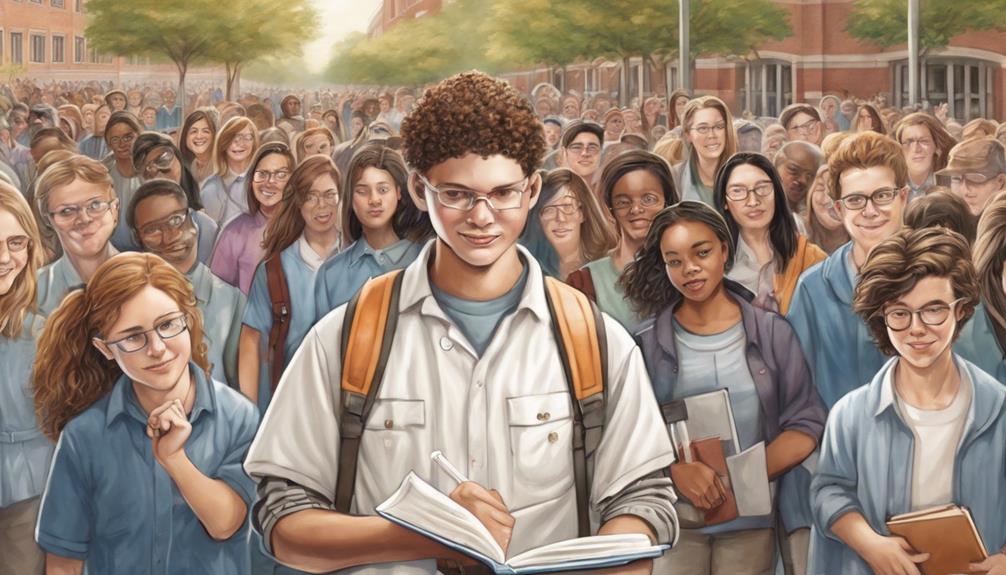
As we explore the topic of pioneering advocacy work in Helen Keller's journey, we uncover the profound impact of her advocacy efforts.
Keller's trailblazing initiatives set the stage for improved rights and opportunities for the deaf-blind community.
Her dedication to advocacy continues to inspire individuals with disabilities to champion their rights and pursue their aspirations.
Advocacy Impact
Pioneering advocacy efforts by Helen Keller significantly reshaped societal perceptions and opportunities for individuals with disabilities, leaving a lasting impact on creating a more inclusive society. Keller's tireless work in advocating for disability rights and education has had a profound effect on enhancing awareness and fostering equal opportunities. Her advocacy efforts not only influenced policies and practices but also inspired a societal shift towards a more inclusive approach.
Keller's legacy continues to drive ongoing initiatives aimed at promoting equal rights and creating a more accessible environment for individuals with disabilities.
- Keller's advocacy work inspired changes in societal attitudes towards disabilities.
- Her efforts led to improvements in educational opportunities for individuals with disabilities.
- Keller's advocacy work highlighted the importance of disability awareness.
- She fought for the rights of individuals with disabilities to be recognized and respected.
- Keller's advocacy work laid the foundation for a more inclusive society.
Trailblazing Initiatives
Advocacy efforts championed by Helen Keller paved the way for trailblazing initiatives that revolutionized societal attitudes towards disabilities and fostered a more inclusive environment for individuals with diverse needs. Keller's groundbreaking achievement at Radcliffe College in 1904 showcased the potential of individuals with disabilities to excel academically, opening doors to greater educational opportunities. Her journey highlighted the values of perseverance, determination, and the crucial role of support in overcoming challenges. By earning her BA degree, Keller not only demonstrated her own capabilities but also challenged stereotypes and inspired a shift towards more inclusive practices. Keller's legacy continues to inspire efforts that promote equal access to education and empower individuals of all abilities to pursue their dreams.
| Trailblazing Initiatives | ||
|---|---|---|
| Educational Opportunities | Perseverance | Determination |
| Support | Inclusivity | Empowerment |
Personal Growth and Resilience

Helen Keller's remarkable journey to earning a Bachelor of Arts degree showcased her unwavering personal growth and resilience in the face of deafness and blindness. Keller's determination and perseverance were key factors in her academic success, allowing her to master Braille, sign language, and tactile communication methods despite her disabilities. Through dedication and hard work, she not only excelled academically but also inspired countless individuals along the way.
- Mastering Communication: Keller's ability to learn and adapt different communication methods highlighted her resilience and commitment to overcoming challenges.
- Educational Excellence: Keller's groundbreaking academic achievements as the first deaf-blind person to earn a BA underscored her unwavering determination and perseverance.
- Inspiring Others: Keller's journey inspired many, showing that with resilience and hard work, any obstacle can be overcome.
- Personal Development: Keller's growth as an individual throughout her educational journey exemplified the power of resilience in facing adversity.
- Legacy of Resilience: Keller's legacy continues to inspire individuals to embrace challenges with courage and resilience, fostering a mindset of continuous growth and learning.
Impact on Deaf-Blind Community
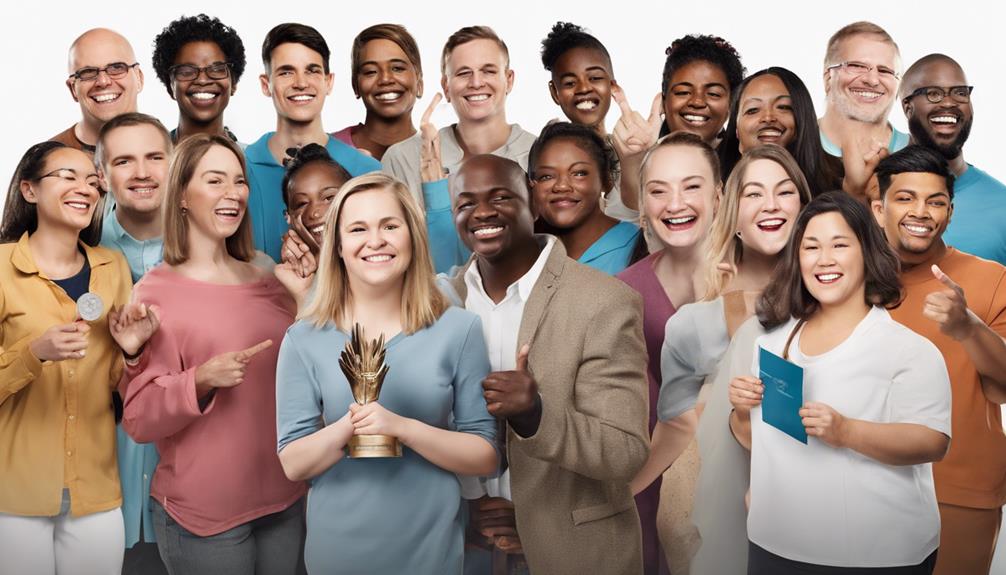
The impact of Helen Keller's educational achievements on the deaf-blind community has been profound and far-reaching. Keller's groundbreaking success as the first deaf-blind person to earn a Bachelor of Arts degree has inspired individuals within the deaf-blind community worldwide. Her journey exemplifies the power of perseverance, highlighting the importance of determination in overcoming obstacles. By showcasing the capabilities and potential of deaf-blind individuals in higher education, Keller's achievements have paved the way for greater inclusivity and recognition for this community.
Through Keller's academic accomplishments, a spotlight has been cast on the need for equal educational opportunities for all, emphasizing the importance of creating an environment where individuals with disabilities, including those who are deaf-blind, can thrive and succeed. Keller's journey serves as a beacon of hope and encouragement, reminding us all of the incredible achievements that can be reached through dedication and resilience. Her legacy continues to inspire future generations to pursue their educational goals and push boundaries in the face of adversity.
Inspirational Journey to Graduation

As we reflect on the inspirational journey to graduation, we recognize the power of overcoming challenges together.
It's through the strength of our support systems that we navigate the hurdles towards academic success.
Let's celebrate the resilience and determination that pave the way for achieving remarkable milestones.
Overcoming Challenges Together
In our collective journey towards graduation, the bond between a determined student and a dedicated teacher illuminated the path to overcoming seemingly insurmountable challenges. Helen Keller and Anne Sullivan's story exemplifies the power of perseverance, mentorship, teamwork, and determination in conquering disabilities and achieving graduation. Together, they showcased:
- The transformative impact of dedicated support and education.
- Innovative teaching methods that broke barriers.
- The importance of collaborative effort in achieving milestones.
- A testament to resilience and determination in the face of adversity.
- The incredible results of unwavering dedication and belief in one another.
Their inspirational journey serves as a beacon of hope and a reminder of the remarkable achievements possible through shared determination and support.
Support System Strengthens
Navigating the challenging path to graduation, a robust support system fortified Helen Keller's inspirational journey towards becoming the first deaf-blind person to earn a Bachelor of Arts degree. Anne Sullivan's mentorship and innovative teaching methods were instrumental in helping Keller develop effective communication skills and overcome the unique challenges she faced.
Keller's perseverance and the unwavering teamwork between her and Sullivan exemplified the strength that can arise from a supportive partnership. Together, they demonstrated the power of resilience in the face of adversity, inspiring others to pursue their educational aspirations despite obstacles.
Keller's remarkable achievement highlighted the importance of a strong support system, determination, and self-belief in achieving academic success against all odds.
Academic Success Celebrated
Celebrating Helen Keller's remarkable journey to graduation as the first deaf-blind person to earn a Bachelor of Arts degree showcases unparalleled perseverance and dedication to academic excellence. Keller's academic success at Radcliffe College in 1904 was a testament to her unwavering commitment to learning, inspiring inclusivity and breaking barriers for the deaf-blind community. Her graduation with honors not only highlighted the power of education but also emphasized the importance of equal access to educational resources for all individuals. Keller's story serves as a beacon of hope, proving that with resilience and determination, extraordinary accomplishments are within reach for everyone.
- Keller's graduation with honors symbolized triumph over adversity.
- Her academic achievements challenged societal perceptions of disabilities.
- Keller's journey emphasized the significance of perseverance in education.
- The inclusivity she championed paved the way for future generations.
- Keller's legacy continues to inspire individuals to overcome obstacles and strive for success.
Celebrating the BA Achievement
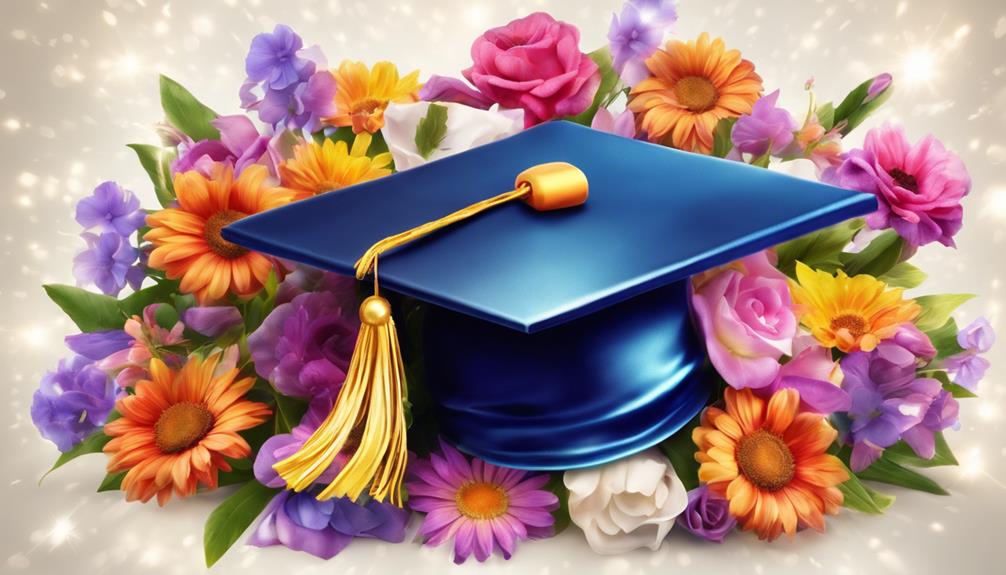
With Keller's groundbreaking achievement, a beacon of inspiration illuminates the path for those facing similar challenges in pursuit of higher education. Helen Keller's attainment of a BA degree from Radcliffe College in 1904 stands as a testament to the unwavering power of determination, resilience, and the transformative impact of education, especially for individuals with disabilities. Keller's journey not only shattered barriers but also emphasized the vital role education plays in empowering individuals to reach their full potential.
Her BA degree not only symbolized academic success but also served as a catalyst for her to become an influential author, activist, and advocate for the deaf-blind community. Keller's triumph continues to echo through time, reminding us of the importance of perseverance and the boundless possibilities that education can offer, regardless of the obstacles one may face. The celebration of Keller's BA achievement fuels the flames of ambition in all individuals striving to overcome adversity and achieve their educational aspirations.
Recognition and Media Attention

Amidst the spotlight of media attention, Helen Keller's groundbreaking achievement as the first deaf-blind person to earn a Bachelor of Arts degree from Radcliffe College in 1904 resonated globally, showcasing unparalleled perseverance and determination. Keller's graduation with honors garnered widespread recognition and admiration, shedding light on the capabilities of individuals with disabilities and inspiring a wave of inclusivity and support.
The media attention surrounding Keller's academic feat not only celebrated her personal triumph but also symbolized a significant step towards breaking down barriers for the deaf-blind community. Here are five aspects that underline the impact of Helen Keller's graduation on society:
- Keller's journey exemplified the transformative power of education and determination in overcoming seemingly insurmountable challenges.
- The media coverage of Keller's graduation brought awareness to the struggles and successes of deaf-blind individuals, fostering a more understanding and inclusive society.
- Keller's achievement highlighted the importance of providing equal opportunities and support for individuals with disabilities in academic settings.
- The global recognition of Keller's milestone paved the way for increased advocacy and resources for the deaf-blind community.
- Keller's story continues to inspire future generations to pursue their aspirations with resilience and unwavering dedication.
Future Goals and Aspirations
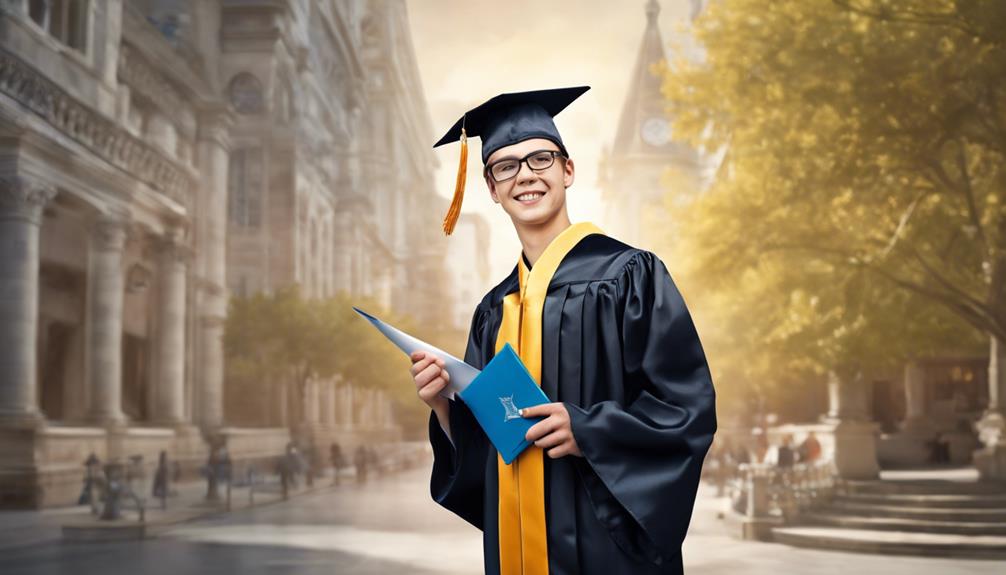
Helen Keller's groundbreaking achievement as the first deaf-blind person to earn a Bachelor of Arts degree from Radcliffe College in 1904 paved the way for her future goals and aspirations centered around advocating for disability rights and education for the deaf-blind community.
Keller's vision extended beyond personal success, aiming to raise awareness about the challenges faced by individuals with disabilities. She aspired to inspire others to overcome obstacles and achieve their goals, regardless of their circumstances.
In her quest for inclusivity, Keller sought to promote equal opportunities for all, irrespective of disabilities, through continued activism, writing, and speaking engagements. Her dedication to advocating for disability rights and education for the deaf-blind community remains a beacon of inspiration, urging us to push boundaries, challenge norms, and foster a more inclusive society.
Through her tireless efforts, Keller set a precedent for future generations to embrace activism and strive for positive change in the world.
Lessons Learned and Takeaways

In reflecting on Helen Keller's remarkable journey, one can't help but draw valuable lessons and meaningful takeaways that resonate deeply with the human spirit. Keller's historic achievement at Radcliffe College stands as a testament to the power of determination, perseverance, and education in the face of adversity. Through her inspirational story, we glean insights that transcend time and circumstance, offering guidance and encouragement to all who face challenges on their paths to success.
- Mentorship: Keller's relationship with Anne Sullivan underscores the transformative impact of mentorship in unlocking one's full potential.
- Determination: Keller's unwavering resolve to pursue her education despite profound sensory limitations teaches us the importance of staying committed to our goals.
- Education: Keller's thirst for knowledge and continuous learning exemplifies how education can empower individuals to break barriers and achieve greatness.
- Perseverance: Keller's resilience in the face of immense obstacles serves as a beacon of hope for those navigating their own struggles.
- Inspiration: Keller's groundbreaking accomplishment continues to inspire generations, reminding us that with courage and perseverance, anything is possible.
Legacy and Continued Influence
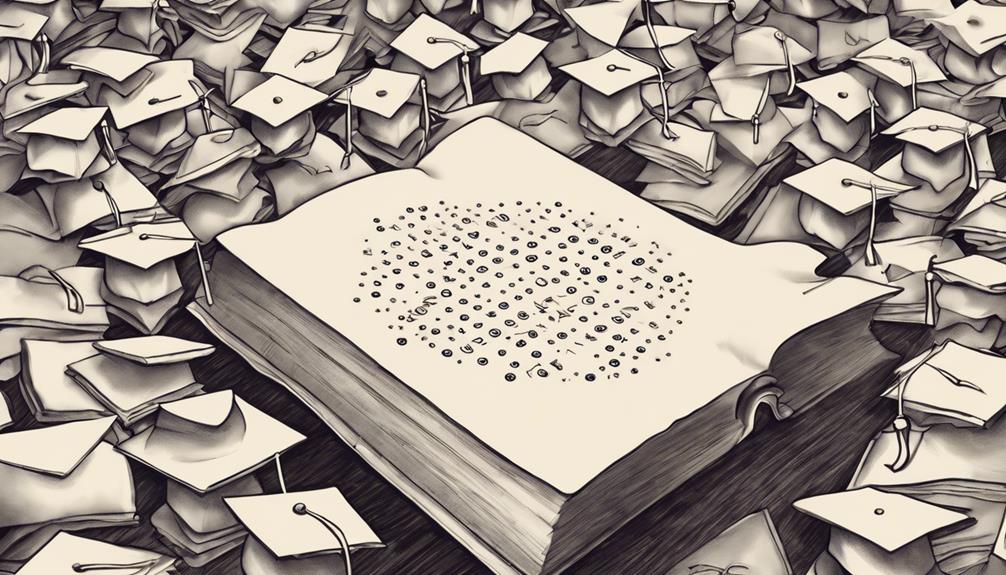
With a profound impact that reverberates through time, Helen Keller's enduring legacy as the first deaf-blind person to earn a Bachelor of Arts degree continues to inspire individuals facing challenges. Keller's journey exemplifies the power of perseverance and determination in overcoming barriers, emphasizing the importance of inclusive education and equal opportunities for individuals with disabilities. By breaking boundaries, she opened doors for the deaf-blind community, paving the way for enhanced educational prospects.
| Legacy | Influence |
|---|---|
| Perseverance | Inspiring others |
| Determination | Breaking barriers |
| Inclusive education | Equal opportunities |
| Overcoming obstacles | Shaping future |
Keller's legacy serves as a beacon of hope, reminding us of the transformative impact of resilience and the necessity of creating a more inclusive society. Her influence continues to shape perceptions, encouraging individuals to strive for academic and personal success despite adversities. Through Keller's remarkable accomplishments, the world learns that with determination and support, any obstacle can be overcome.
Frequently Asked Questions
Who Was the First Deaf-Blind Person to Earn a Ba?
We believe the first deaf-blind person to earn a BA was Helen Keller, who graduated cum laude from Radcliffe College in 1904. Her remarkable journey inspires individuals worldwide.
Keller's achievement emphasizes the importance of accessibility and support for those with sensory impairments pursuing higher education.
Her success opened doors for greater opportunities and inclusivity in the education system for deaf-blind individuals.
Who Was the First Deaf-Blind Person to Graduate?
We're the first deaf-blind person to graduate. It's a groundbreaking achievement, showcasing the power of perseverance and determination in the face of adversity. Our journey inspires individuals worldwide, highlighting the importance of inclusive education.
Who Was Famous for Being Blind and Deaf?
We all know Helen Keller was famous for being blind and deaf. Her remarkable journey of resilience and determination inspired many. Despite her disabilities, Keller's educational achievements showcased the power of perseverance.
Graduating with honors from Radcliffe College, she became the first deaf-blind person to earn a Bachelor of Arts degree. Keller's accomplishments marked a significant milestone in the history of individuals with disabilities, highlighting the importance of determination and overcoming obstacles.
Who Is the American Author the First Deaf-Blind Person to Earn a Bachelor's Degree and Published an Autobiography the Story of My Life at the Age of 22?
We're talking about Helen Keller, the incredible American author who, at 22, became the first deaf-blind person to earn a Bachelor's degree and wrote the autobiography 'The Story of My Life.'
It's truly inspiring how Keller's determination and resilience paved the way for so many. Her story is a testament to the power of overcoming challenges and the importance of inclusivity for all.
Helen Keller's legacy continues to inspire and educate us today.
How Did the First Deaf-Blind Person Overcome Challenges to Earn a BA and Can Deaf Students Find Part-Time Jobs?
Helen Keller, the first deaf-blind person to earn a BA, overcame immense challenges through resilience and determination. Deaf students can find comprehensive part-time job options with companies that value diversity and provide accommodations for individuals with disabilities.
Conclusion
In conclusion, Helen Keller's journey as the first deaf-blind person to earn a Bachelor of Arts degree is like a beacon of light shining through the darkness, illuminating the path of determination and resilience.
Her legacy serves as a reminder that with perseverance and support, any obstacle can be overcome.
Keller's story continues to inspire us to strive for greatness and advocate for inclusivity and equal opportunities for all.

